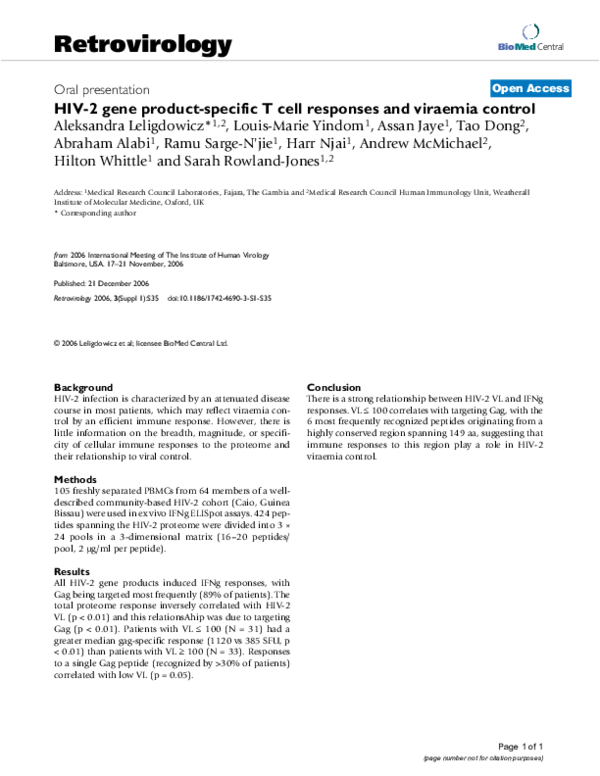Academia.edu no longer supports Internet Explorer.
To browse Academia.edu and the wider internet faster and more securely, please take a few seconds to upgrade your browser.
HIV-2 gene product-specific T cell responses and viraemia control
HIV-2 gene product-specific T cell responses and viraemia control
HIV-2 gene product-specific T cell responses and viraemia control
HIV-2 gene product-specific T cell responses and viraemia control
HIV-2 gene product-specific T cell responses and viraemia control
Retrovirology
Related Papers
Retrovirology
Undetectable plasma viral load predicts normal survival in HIV-2-infected people in a West African village2010 •
2013 •
2008 •
2008 •
2005 •
Retrovirology
Acute mucosal pathogenesis of feline immunodeficiency virus is independent of viral dose in vaginally infected cats2010 •
Journal of Clinical Investigation
Robust Gag-specific T cell responses characterize viremia control in HIV2 infection2007 •
Retrovirology
BioMed Central
Open Access
Oral presentation
HIV-2 gene product-specific T cell responses and viraemia control
Aleksandra Leligdowicz*1,2, Louis-Marie Yindom1, Assan Jaye1, Tao Dong2,
Abraham Alabi1, Ramu Sarge-N'jie1, Harr Njai1, Andrew McMichael2,
Hilton Whittle1 and Sarah Rowland-Jones1,2
Address: 1Medical Research Council Laboratories, Fajara, The Gambia and 2Medical Research Council Human Immunology Unit, Weatherall
Institute of Molecular Medicine, Oxford, UK
* Corresponding author
from 2006 International Meeting of The Institute of Human Virology
Baltimore, USA. 17–21 November, 2006
Published: 21 December 2006
Retrovirology 2006, 3(Suppl 1):S35
doi:10.1186/1742-4690-3-S1-S35
<supplement> <title> <p>2006 International Meeting of The Institute of Human Virology</p> </title> <note>Meeting abstracts. A single PDF containing all abstracts in this Supplement is available <a href=" http://www.biomedcentral.com/content/files/pdf/1742-4690-3-S1-full.pdf ">here</a></note> <url>http://www.biomedcentral.com/content/pdf/1742-4690-3-S1-info.pdf</url></supplement>
© 2006 Leligdowicz et al; licensee BioMed Central Ltd.
Background
Conclusion
HIV-2 infection is characterized by an attenuated disease
course in most patients, which may reflect viraemia control by an efficient immune response. However, there is
little information on the breadth, magnitude, or specificity of cellular immune responses to the proteome and
their relationship to viral control.
There is a strong relationship between HIV-2 VL and IFNg
responses. VL ≤ 100 correlates with targeting Gag, with the
6 most frequently recognized peptides originating from a
highly conserved region spanning 149 aa, suggesting that
immune responses to this region play a role in HIV-2
viraemia control.
Methods
105 freshly separated PBMCs from 64 members of a welldescribed community-based HIV-2 cohort (Caio, Guinea
Bissau) were used in ex vivo IFNg ELISpot assays. 424 peptides spanning the HIV-2 proteome were divided into 3 ×
24 pools in a 3-dimensional matrix (16–20 peptides/
pool, 2 μg/ml per peptide).
Results
All HIV-2 gene products induced IFNg responses, with
Gag being targeted most frequently (89% of patients). The
total proteome response inversely correlated with HIV-2
VL (p < 0.01) and this relationsAhip was due to targeting
Gag (p < 0.01). Patients with VL ≤ 100 (N = 31) had a
greater median gag-specific response (1120 vs 385 SFU, p
< 0.01) than patients with VL ≥ 100 (N = 33). Responses
to a single Gag peptide (recognized by >30% of patients)
correlated with low VL (p = 0.05).
Page 1 of 1
(page number not for citation purposes)
RELATED TOPICS
- Find new research papers in:
- Physics
- Chemistry
- Biology
- Health Sciences
- Ecology
- Earth Sciences
- Cognitive Science
- Mathematics
- Computer Science

 Abraham Alabi
Abraham Alabi